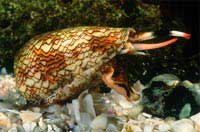 There are dozens of species of crown-of-thorns sea snails, varying in size, beautiful shells, and a spectrum of colors. All of them possess venom. They have developed a unique hunting technique: using spears. From preemptive strategies to passive defense, and from the use of chemical weapons to territorial marking, these sea creatures demonstrate mastery in avoiding predators and capturing prey.
There are dozens of species of crown-of-thorns sea snails, varying in size, beautiful shells, and a spectrum of colors. All of them possess venom. They have developed a unique hunting technique: using spears. From preemptive strategies to passive defense, and from the use of chemical weapons to territorial marking, these sea creatures demonstrate mastery in avoiding predators and capturing prey.
1. Preemptive Strategies
These marine animals are well-armed, but to minimize conflict, they choose to warn predators with their bright body colors, signaling: “Danger, do not touch me.”
Sea Cucumber
With a long, soft body surrounded by branched tentacles, at the tips of which edible particles and microorganisms cling. Periodically, the sea cucumber curls each tentacle towards its central mouth and sucks, which is why it is named “finger-licking sea cucumber.” While most of its kind are light brown, this species displays vibrant colors, standing out in its habitat as a warning to others. This beautiful creature is rarely seen in aquariums, as when disturbed, it releases toxins into the water, poisoning the tank’s inhabitants.
Fire Worm
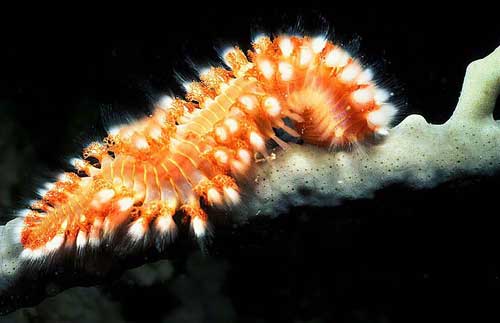 |
|
Source: Petsforum |
This segmented worm is easily recognizable due to its fiery-colored appearance. A layer of fine white bristles extends around its body: sharp, with hooks that can break easily. These bristles penetrate the skin, causing a burning and itching sensation, which can sometimes be very painful. This phenomenon is likely physical, as no venom has been found on the bristles.
Flying Fish
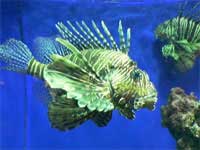 |
|
Flying Fish (photogalery) |
It swims sluggishly, flaunting its striped skin. This confidence likely comes from its formidable strength: its venom contains very potent toxins. The fish bears a type of long dorsal spines with serrated grooves that fan out like wings. Besides the sharp pain, the venom can induce shock, particularly dangerous for divers. The affected area swells and heals slowly. In some cases, poisoning can lead to systemic disorders, causing cardiac or respiratory failure, and even death.
Blue-Ringed Octopus
This tiny octopus species, measuring no more than 10 cm, delivers a highly toxic bite that can be fatal. Dubbed the “tiny killer,” it often appears in tide pools during low tide. Picking it up with your hands for a closer look could lead to death. Its bite may be painless at first, but it causes localized numbness that spreads throughout the body. Within 1-2 hours, numbness transitions to paralysis of limbs and respiratory muscles. In marine life, dangerous species often have distinctive colors: blue spots on a yellow background.
Blue-Spotted Stingray
The danger lies in its sturdy, spiky tail, which carries venom in the middle. If threatened, the stingray lashes its tail forward like a whip, creating a tear wound that is extremely painful and prone to infection. Symptoms include fever and spasms.
Boxfish
 |
|
Boxfish. (photogalery) |
This fish is relatively immobile, encased in a bony box-like structure, with only flexible parts like the tail, fins, and eyes protruding. The venom beneath its skin is very potent, released whenever the fish intends to bite. It is small, with a yellow body and a blue tail, making it visually appealing.
2. Passive Defense Mechanisms
Crown-of-Thorns Starfish
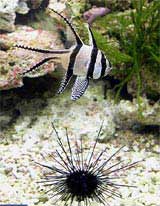 |
| Crown-of-Thorns Starfish (photogalery) |
With long, protruding spines all over its body, the spines have hooks that can break easily. Except for animals that prey on crown-of-thorns or those with large, strong jaws, other species should stay away. If stepped on carelessly, immediate sharp pain occurs, even though no venom is visible on the starfish. The spines penetrate deeply, making them difficult to remove or dissolve. To avoid complications, a cut is necessary to extract the spines.
Sea Urchin
This formidable coral-eating creature scrapes away about half a meter of coral daily, leaving behind a white mineral skeleton. These sea urchins gather in groups, forming a toxic spiked carpet. Its sting is very painful, causing swelling and numbness that can temporarily paralyze the stung area.
Scorpaenidae
This tropical fish species has skin patches that resemble waving seaweed, with a light red color that shines brightly under light. However, it is hard to detect in the dim light underwater. The fish has venomous spines, especially on its dorsal fin and gill covers.
Stonefish
 |
|
Stonefish (photogalery) |
This fish is the champion of venomous fish; a sting can be fatal. Unfortunately, its camouflage is remarkable, remaining almost completely motionless in its environment, sometimes found in shallow water, with spines easily penetrating shoes if stepped on. The sting from this fish is excruciating, sometimes causing shock. The affected area swells. The venom also affects the nervous system, causing convulsions, paralysis, heart or respiratory disorders, and can lead to death. Antivenom exists and is effective if administered quickly but must be kept cold when transported. If antivenom is unavailable, wash the wound with plenty of water and quickly heat the sting area (to a tolerable limit) to neutralize the venom, as it often deteriorates when exposed to heat. For example, immersing the sting site in 48°C water or using a hair dryer to a tolerable limit can help deactivate some of the venom before it spreads. A solution is to use a vacuum syringe to help extract some of the venom.
Fire Coral
These coral branches are yellow with bright edges, found in shallow rocky areas. Despite being called coral, it actually belongs to the group of hydrozoans. Contact with fire coral causes immediate sharp pain, red spots on the skin, and sometimes a more severe reaction, accompanied by a burning sensation, increasing the risk of infection.
3. Use of Chemical Weapons
Sea Anemone
This creature looks like a moving flower, but usually remains stationary, attached to rocks. It still needs to eat to survive. Unable to chase prey, it relies on its stinging tentacles. When prey approaches, the stinging tentacles release countless tiny stinging cells that irritate and quickly paralyze the prey.
Squid
Squid feast on crabs, shrimp, and other crustaceans. Capturing these hard-shelled prey is not too difficult for them, as they possess thousands of suckers. Using its hard beak, the squid drills a hole in the prey’s tough shell and injects saliva that paralyzes the prey, liquefying its tissues for the squid to suck up.
Jellyfish
Some species are harmless, while others are terrifying. One jellyfish species, not very large with a diameter of 10 cm, drags along tentacles that can reach 10 m long, allowing it to catch plankton. These tentacles cause severe itching if touched by humans. Among tropical jellyfish species, those known as “the sea wasp” have a diameter of only a few centimeters but can be fatal. (An antivenom for jellyfish stings is now available).
4. Territorial Defense
They prefer to live within minimal space. Any intruder crossing this boundary will be attacked immediately.
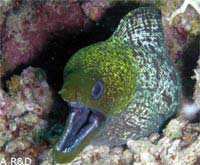 |
|
Moray Eel (photogalery) |
Moray Eel
It only lives around its den. From the entrance, it observes the world, but with poor eyesight, it can become aggressive easily. If you carelessly touch the entrance to its den, the moray eel will bite immediately, delivering a highly venomous bite that takes a long time to heal.
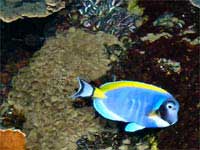 |
|
Surgeonfish. (photogalery) |
Surgeonfish
These herbivorous animals usually frequent shallow waters, particularly in coral areas where many short algae species thrive. Instead of moving in schools, they scatter, each protecting a garden of algae several square meters. They ambush intruders swiftly. Their weapons are “scalpel” spines at both ends of their tails. This orange spine usually folds forward but stands erect during combat. Adult fish can grow up to 40 cm in length, with 3 cm long spines that are sharp as knives; with just a flick of the tail, the spines can penetrate diving suits.


















































